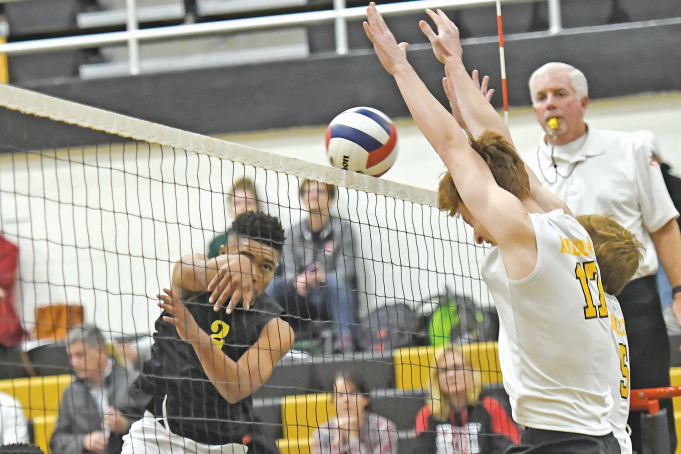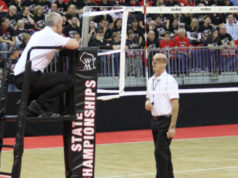Volleyball referees are tasked with making many split-second decisions during a match. One area where coaches, spectators, players and referees see things differently is when an attacked ball is near the top of the net and blockers are attempting to prevent the ball from entering into their playing space.
Did the blockers touch the ball or not? This is an important question because the attacking team will get three more contacts or the opponent will win the rally and point. But this is no simple question to answer.
What is going on leading up to this decision?
For the first referee:
- He or she is watching play develop.
- If the setter is setting the ball to a teammate, was it a legal contact?
- Can the setter dump the ball over (if front row) or should he or she be prepared for a possible violation (if back row)? • Is the attacker a front-row player or is he or she coming out of the back row?
- Where was the attacker’s last point of contact if a back-row player?
- Was the final contact legal (often the third contact)?
- Did the blockers touch the ball or not, resulting in four hits on the attacking team?
For the second referee:
- He or she is watching play develop.
- Does he or she need to help with caught and thrown contacts or egregious double contacts when partners are blocked from seeing the contact (this should be discussed in prematch)?
- Is he or she in position to view the attacker’s last point of contact to assist with back-row attacks?
- Is he or she in position and ready to help the first referee determine if the libero was on the attack line or in the front zone and used finger action to send the ball to a teammate who makes an attack on the ball (that attack being higher than the top of the net)?
- Can he or she identify which players are blocking and did they make contact with the net during the action of playing the ball?
- Is he or she anticipating and prepared to whistle (if necessary) centerline violations by either team?
- Can he or she confidently assist the first referee in determining whether the blockers touched the ball or not?
As you can see, both referees have a constant flow of information — known as the progression of play — in which they evaluate, anticipate, communicate and make decisions. The coaches, spectators and players don’t see the game as we do and fail to recognize that the final piece for both referees is only a small part of their job. Of course, it’s an important piece (a big decision) so let’s cover some recent statistics, what affects our view and decisions, and how we can improve our decision-making on determining first hit or four hits.
Statistics on this play (some may say a 50-50 play):
FIVB, the international governing body of volleyball, conducted some studies on attacked balls that were “close” to the top of the net tape. The primary objective was to review video of these “close” plays and determine how often the blockers contacted the ball. The results indicated that it is far from a 50-50 play.
In these studies, blockers touched the ball on these “close” plays more than 80 percent of the time. In fact, one study put the numbers closer to 90 percent! As an amateur statistician, I like those numbers and coaches should too. Unless a ball is clearly blocked or is clearly contacted four times, allowing play to continue is the best decision because it will be the correct decision 80-90 percent of the time.
Why is it so difficult to see?
The speed (or level) of play can make it difficult to determine if an attack was touched by the block.
The first referee is responsible for seeing the third contact, then shifting his or her focus to the net where the play is occurring. This is easier to say than to do.
The second referee is responsible for seeing net violations and his or her focus has to go from bottom to top, then top to bottom, which is a lot to take in.
The angle and speed of the attack can make it difficult to determine whether the block touches the ball:
- Roll shots
- Hard hit attacks
- Crosscourt hits
- Low attacks
- High above the net (top level play)
The type of play, or offense, that a team runs can make seeing blocker touches difficult:
- High and outside
- Quick set in the middle
- Slide
- Coming out of the back row (the BIC)
Additional factors that impact referees’ decisions:
- We are looking through hands.
- We may be behind the hands (depending on position).
- We are in line with the net, which is not always the best angle.
- We are affected by the number of blockers (lots of hands).
- We may be affected by the match equipment (a shaking net).
- We could be fooled by the deflection of the ball once it’s been in the net or touched by the blockers.
- We could be influenced by players saying “no touch,” coaches yelling at us because they disagree, or hearing fan reaction.
Let’s get better
So, how can each referee improve in this area of the game and make the correct call on a more consistent basis?
The first referee:
He or she should work on strengthening their ability to shift focus from one area to the next. For example, seeing the final team contact and deciding on its legality and then getting to the area of the net where play is occurring. Here you will determine if the attacked ball is touched by the blocker(s) or not.
Furthermore, he or she should maintain focus at the net for a brief moment, rather than trying to be ahead of the play to see where the ball lands (that’s why we have line judges) or to view the first team contact. This pause will keep him or her ultra-focused in the right spot at the right time to make a better decision on touch versus no touch.
Remember, we don’t worry about double contacts on first ball contacts anymore so there is no need to hurry away from the net. Additionally, after that brief pause at the net to catch touches, if you turn to find the ball and the first player contacting it is still “holding” it, you may consider whistling a violation.
The second referee:
He or she can be a stronger partner and help identify possible four hits by improving two things: 1) where they stand in relation to the pole, and 2) where and when they are looking. As the ball is set toward one antenna or the other, the second referee’s front-to-back position in relation to the pole could create a better view. If the goal is to see more and be a better help to our partner, we should be prepared to optimize our field of vision and perspective by moving accordingly.
Additionally, a second referee may occasionally perform a secondary transition that would adjust their side-to-side position and allow for a different perspective on the attack-block play. Of course, secondary transitions should only be used when necessary and movements should be done with purpose. The second referee would not want to sacrifice their view of the net or centerline (primary responsibilities) to help with a touch or not (secondary responsibility). This is where I like to tell new referees, “Don’t just be at the match, but be in the match.” In other words, you should know when to move, how to move, why to move, when it’s OK to shift your responsibilities, and how you can best help your partner without neglecting your own duties.
When you boil it all down, proper positioning and correct focus are the keys for both referees to becoming better decision makers and getting this call correct.
The four-hits or first-contact call will always be one of the most difficult calls volleyball referees have to determine. Even when using the most proven techniques by some of the top officials in our industry, the question will still come from coaches, fans and even from yourself if you made the right call on that play. This is where you have to understand your limitations as a human.
While the technology of the challenge system is a great asset for those officiating on some of the highest levels of the NCAA, it cannot help the official who is working a high school, lower-level college or USAV match. Be respectful of coaches and captains who may question the call. But at the end of the day, it’s a judgment call.
Bill Thornburgh, Simpsonville, Ky., is a National USAV and PAVO referee, as well as a FIVB International referee. He works in the Big Ten, ACC, SEC and other D-I conferences in the Midwest.
What's Your Call? Leave a Comment:
Note: This article is archival in nature. Rules, interpretations, mechanics, philosophies and other information may or may not be correct for the current year.
This article is the copyright of ©Referee Enterprises, Inc., and may not be republished in whole or in part online, in print or in any capacity without expressed written permission from Referee. The article is made available for educational use by individuals.



















